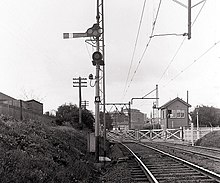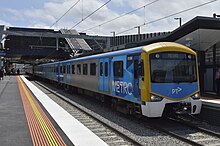
Sandringham line

| Sandringham line | |||||||||||||||||||||||||||||||||||||||||||||||||||||||||||||||||||||||||||||||||||||||||||||||||||||||||||||||||||||||||||||||||||||||||||||
|---|---|---|---|---|---|---|---|---|---|---|---|---|---|---|---|---|---|---|---|---|---|---|---|---|---|---|---|---|---|---|---|---|---|---|---|---|---|---|---|---|---|---|---|---|---|---|---|---|---|---|---|---|---|---|---|---|---|---|---|---|---|---|---|---|---|---|---|---|---|---|---|---|---|---|---|---|---|---|---|---|---|---|---|---|---|---|---|---|---|---|---|---|---|---|---|---|---|---|---|---|---|---|---|---|---|---|---|---|---|---|---|---|---|---|---|---|---|---|---|---|---|---|---|---|---|---|---|---|---|---|---|---|---|---|---|---|---|---|---|---|---|
 | |||||||||||||||||||||||||||||||||||||||||||||||||||||||||||||||||||||||||||||||||||||||||||||||||||||||||||||||||||||||||||||||||||||||||||||
 Comeng train on the Sandringham line at Prahran station, December 2019 | |||||||||||||||||||||||||||||||||||||||||||||||||||||||||||||||||||||||||||||||||||||||||||||||||||||||||||||||||||||||||||||||||||||||||||||
| Overview | |||||||||||||||||||||||||||||||||||||||||||||||||||||||||||||||||||||||||||||||||||||||||||||||||||||||||||||||||||||||||||||||||||||||||||||
| Service type | Commuter rail | ||||||||||||||||||||||||||||||||||||||||||||||||||||||||||||||||||||||||||||||||||||||||||||||||||||||||||||||||||||||||||||||||||||||||||||
| System | Melbourne railway network | ||||||||||||||||||||||||||||||||||||||||||||||||||||||||||||||||||||||||||||||||||||||||||||||||||||||||||||||||||||||||||||||||||||||||||||
| Status | Operational | ||||||||||||||||||||||||||||||||||||||||||||||||||||||||||||||||||||||||||||||||||||||||||||||||||||||||||||||||||||||||||||||||||||||||||||
| Locale | Melbourne, Victoria, Australia | ||||||||||||||||||||||||||||||||||||||||||||||||||||||||||||||||||||||||||||||||||||||||||||||||||||||||||||||||||||||||||||||||||||||||||||
| Predecessor |
| ||||||||||||||||||||||||||||||||||||||||||||||||||||||||||||||||||||||||||||||||||||||||||||||||||||||||||||||||||||||||||||||||||||||||||||
| First service | 19 December 1859 | ||||||||||||||||||||||||||||||||||||||||||||||||||||||||||||||||||||||||||||||||||||||||||||||||||||||||||||||||||||||||||||||||||||||||||||
| Current operator(s) | Metro Trains | ||||||||||||||||||||||||||||||||||||||||||||||||||||||||||||||||||||||||||||||||||||||||||||||||||||||||||||||||||||||||||||||||||||||||||||
| Former operator(s) |
| ||||||||||||||||||||||||||||||||||||||||||||||||||||||||||||||||||||||||||||||||||||||||||||||||||||||||||||||||||||||||||||||||||||||||||||
| Route | |||||||||||||||||||||||||||||||||||||||||||||||||||||||||||||||||||||||||||||||||||||||||||||||||||||||||||||||||||||||||||||||||||||||||||||
| Termini | Flinders Street Sandringham | ||||||||||||||||||||||||||||||||||||||||||||||||||||||||||||||||||||||||||||||||||||||||||||||||||||||||||||||||||||||||||||||||||||||||||||
| Stops | 14 | ||||||||||||||||||||||||||||||||||||||||||||||||||||||||||||||||||||||||||||||||||||||||||||||||||||||||||||||||||||||||||||||||||||||||||||
| Distance travelled | 18.090 km (11.241 mi) | ||||||||||||||||||||||||||||||||||||||||||||||||||||||||||||||||||||||||||||||||||||||||||||||||||||||||||||||||||||||||||||||||||||||||||||
| Average journey time | 30 minutes | ||||||||||||||||||||||||||||||||||||||||||||||||||||||||||||||||||||||||||||||||||||||||||||||||||||||||||||||||||||||||||||||||||||||||||||
| Service frequency |
| ||||||||||||||||||||||||||||||||||||||||||||||||||||||||||||||||||||||||||||||||||||||||||||||||||||||||||||||||||||||||||||||||||||||||||||
| Line(s) used | Sandringham | ||||||||||||||||||||||||||||||||||||||||||||||||||||||||||||||||||||||||||||||||||||||||||||||||||||||||||||||||||||||||||||||||||||||||||||
| Technical | |||||||||||||||||||||||||||||||||||||||||||||||||||||||||||||||||||||||||||||||||||||||||||||||||||||||||||||||||||||||||||||||||||||||||||||
| Rolling stock | Comeng, Siemens | ||||||||||||||||||||||||||||||||||||||||||||||||||||||||||||||||||||||||||||||||||||||||||||||||||||||||||||||||||||||||||||||||||||||||||||
| Track gauge | 1,600 mm (5 ft 3 in) | ||||||||||||||||||||||||||||||||||||||||||||||||||||||||||||||||||||||||||||||||||||||||||||||||||||||||||||||||||||||||||||||||||||||||||||
| Electrification | 1500 V DC overhead | ||||||||||||||||||||||||||||||||||||||||||||||||||||||||||||||||||||||||||||||||||||||||||||||||||||||||||||||||||||||||||||||||||||||||||||
| Track owner(s) | VicTrack | ||||||||||||||||||||||||||||||||||||||||||||||||||||||||||||||||||||||||||||||||||||||||||||||||||||||||||||||||||||||||||||||||||||||||||||
| |||||||||||||||||||||||||||||||||||||||||||||||||||||||||||||||||||||||||||||||||||||||||||||||||||||||||||||||||||||||||||||||||||||||||||||
The Sandringham line is a commuter railway line in the city of Melbourne, Victoria, Australia.[1] Operated by Metro Trains Melbourne, it is the city's fourth shortest metropolitan railway line at 17.9 kilometres (11.1 mi). The line runs from Flinders Street station in central Melbourne to Sandringham station in the south-east, serving 14 stations via South Yarra, Balaclava, Elsternwick, and Brighton.[2] The line operates from approximately 5am to 12am, daily, with 24 hour service available on Friday and Saturday nights. Services run every 7–8 minutes during peak hour, with services running every 15 minutes during the inter-peak period on weekdays, and every 20 minutes at night and during the day on weekends (with the exception of early Sunday mornings when services run every 40 minutes). Additionally, services run every 60 minutes overnight on Friday and Saturday nights as part of the Night Network.[3] Trains on the Sandringham line run with a two three-car formations of Comeng or Siemens Nexas trainsets.[4]

Sections of the Sandringham line opened as early as 1859, with the line fully extended to Sandringham in 1887. A limited number of stations were first opened, with infill stations progressively opened between 1860 and 1912.[5] The line was built to connect Melbourne with the suburbs of Balaclava, Elsternwick, Brighton, and Sandringham, amongst others. Minor upgrades have occurred since its opening, including historical level crossing removal works and regular infrastructure upgrades.[6]

History
19th century
The Melbourne and Suburban Railway Company opened their line from Princes Bridge (later amalgamated with Flinders Street station) to a temporary station on Punt Road in February 1859, then to Cremorne (now closed) in December of that year. Shortly after, the St Kilda and Brighton Railway Company opened their railway line from St Kilda to Bay Street (now North Brighton) in December 1859. Twelve months after that, the Melbourne and Suburban Railway Company extended their line from Cremorne to Chapel Street (now Windsor) station, on the St Kilda and Brighton Railway Company's line, providing a second route to the city from the Brighton line. The following year, again in December, the St Kilda and Brighton Railway Company extended their line to Beach (now Brighton Beach).

The link between St Kilda and Windsor, disused since 1862, was dismantled in 1867, although part of it at the Windsor end was used as a siding for some time afterwards. In 1865, the Melbourne and Hobson's Bay Railway Company, who owned the St Kilda line, purchased the Melbourne Suburban Railway Company and became the Melbourne and Hobson's Bay United Railway Company, and subsequently bought the St Kilda and Brighton Railway Company, which was in financial difficulties, for £99,500. The Victorian Government acquired the United railway company in July 1878.

In September 1887, the Brighton line was extended to Sandringham.

20th century

The Sandringham line became the first line in Victoria to be provided with automatic signals, with the line as far as Elsternwick converted in stages from 1915 to 1918. Then in 1919, the Sandringham line became, with the line to Essendon, the first line in the country to be electrified (apart from a test installation on the Flemington Racecourse line).[7] Automatic signalling was provided the rest of the way to Sandringham in two stages in during 1926.[7]

When the underground City Loop line was designed, it was not intended to cater for trains on the Port Melbourne, St Kilda, and Sandringham lines. However, a crossover was installed near Richmond to allow Sandringham trains to cross to the tracks used by the Frankston, Pakenham, and Cranbourne line trains, which had access to the underground loop. In 1985, two Sandringham trains each way were altered to run via the underground loop, and in 1987, with the Port Melbourne and St Kilda lines converted to light rail operation, all off-peak and many peak trains were routed via the underground loop.[citation needed] The commencement of operations involved the service stopping at three new stations—Parliament, Melbourne Central (formally Museum), and Flagstaff.[8] The Loop follows La Trobe and Spring Streets along the northern and eastern edges of the Hoddle Grid.[9] The Loop connects with Melbourne's two busiest stations, Flinders Street and Southern Cross, via the elevated Flinders Street Viaduct.[9] From 2021, Sandringham line services stopped operating through the loop as part of a timetable restructure.[10]

21st century
In 2021, the metropolitan timetable underwent a major rewrite, resulting in all Sandringham line trains terminating at Flinders Street without operating through the City Loop.[10]

Future
Network reconfiguration
When the new cross-city rail corridor being built by the Metro Tunnel opens in 2025 there will be a reorganisation of the Melbourne rail network.[11] The Victorian Department of Transport and Planning plans to return the Frankston line to the City Loop, with dedicated use of the Caulfield group tunnel track.[12] This will mean Frankston line trains will no longer through-run with Werribee and Williamstown line trains, and will again stop at City Loop stations Flagstaff, Melbourne Central and Parliament.[12] As part of the reconfiguration, the Sandringham line would instead begin through-running services to Werribee and Williamstown lines for the first time.[12]

Stage 4 of the Network Development Plan – Metropolitan Rail proposed that the Upfield and Sandringham lines be joined via a reconfigured City Loop sometime in the 2030s.[13]

Network and operations
Services
Services on the Sandringham line operates from approximately 5:00am to 12:00am (midnight) daily and all night on Friday and Saturday nights.[14] Services run every 7–8 minutes during peak hour, with services running every 15 minutes during the inter-peak period on weekdays, and every 20 minutes at night and during the day on weekends (with the exception of early Sunday mornings when services run every 40 minutes until 10:00am). Additionally, services run every 60 minutes overnight on Friday and Saturday nights as part of the Night Network.[3] Services don't run via the City Loop, instead they run direct to Flinders Street.[15]

As of December 2024, one express train during a weekday on the Sandringham line is being the 6:05pm Flinders Street service from Sandringham.

Stopping patterns
Legend — Station status

- ◼ Premium Station – Station staffed from first to last train
- ◻ Host Station – Usually staffed during morning peak, however this can vary for different stations on the network.
Legend — Stopping patterns
Services do not operate via the City Loop but trains used to run via City Loop

- ● – All trains stop
- ◐ – Some services do not stop
- ▲ – Only inbound trains stop
- | – Trains pass and do not stop
| Sandringham Services[16] | ||||
|---|---|---|---|---|
| Station | Zone | Local | Ltd Express | Middle Brighton |
| ◼ Flinders Street | 1 | ● | ▲ | ▲ |
| ◼ Richmond | ● | ▲ | ▲ | |
| ◻ Prahran | ● | ▲ | ▲ | |
| ◻ Windsor | ● | ▲ | ▲ | |
| ◼ Balaclava | ● | ▲ | ▲ | |
| ◻ Ripponlea | ● | ▲ | ▲ | |
| ◼ Elsternwick | ● | ▲ | ▲ | |
| Gardenvale | ● | | | ▲ | |
| ◻ North Brighton | 1/2 | ● | | | ▲ |
| ◻ Middle Brighton | ● | | | ▲ | |
| ◼ Brighton Beach | ● | | | ||
| Hampton | 2 | ● | | | |
| ◼ Sandringham | ● | ▲ | ||
Operators
The Sandringham line has had a total of 11 operators since its opening in 1859. The line was initially operated by the Melbourne and Suburban Railway Company, the St Kilda and Brighton Railway Company, the Melbourne Railway Company, and the Melbourne and Hobson's Bay Railway Company over the course of 19 years from 1859 till nationalisation in 1878. The majority of operations throughout its history have been government run: from 1878 until the 1999 privatisation of Melbourne's rail network, four different government operators have run the line.[17] These operators, Victorian Railways, the Metropolitan Transit Authority, the Public Transport Corporation and Bayside Trains have a combined operational length of 121 years.[17]

Bayside Trains was privatised in August 1999 and later rebranded M>Train. In 2002, M>Train was placed into receivership and the state government regained ownership of the line, with KPMG appointed as receivers to operate M>Train on behalf of the state government.[18][19][20] Two years later, rival train operator Connex Melbourne took over the M>Train operations including the Sandringham line. Metro Trains Melbourne, the current private operator, then took over the operations in 2009. These private operators have had a combined operational period of 25 years.[21]

| Operator | Assumed operations | Ceased operations | Length of operations |
|---|---|---|---|
| Melbourne and Suburban Railway Company* | 1859 | 1862 | 3 years |
| St Kilda and Brighton Railway Company* | |||
| Melbourne Railway Company | 1862 | 1865 | 3 years |
| Melbourne and Hobson's Bay Railway Company | 1865 | 1878 | 13 years |
| Victorian Railways | 1878 | 1983 | 105 years |
| Metropolitan Transit Authority | 1983 | 1989 | 6 years |
| Public Transport Corporation | 1989 | 1998 | 9 years |
| Bayside Trains (government operator) | 1998 | 1999 | 1 years |
| M>Train | 1999 | 2004 | 5 years |
| Connex Melbourne | 2004 | 2009 | 5 years |
| Metro Trains Melbourne | 2009 | incumbent | 15 years (ongoing) |
*Operated part of the route

Route
Sandringham line | |||||||||||||||||||||||||||||||||||||||||||||||||||||||||||||||||||||||||||||||||||||||||||||||||||||||||||||||||||||||||||||||||||||||||||||||||||||||||||||||||||||||||||||||||||||||||||||||||||||||||||||||||||||||||||||||||||||||||||||||||||||||||||||||||||||||||||||||||||||||||||||||||||||||||||||||||||||||||||||||||||||||||||||||
|---|---|---|---|---|---|---|---|---|---|---|---|---|---|---|---|---|---|---|---|---|---|---|---|---|---|---|---|---|---|---|---|---|---|---|---|---|---|---|---|---|---|---|---|---|---|---|---|---|---|---|---|---|---|---|---|---|---|---|---|---|---|---|---|---|---|---|---|---|---|---|---|---|---|---|---|---|---|---|---|---|---|---|---|---|---|---|---|---|---|---|---|---|---|---|---|---|---|---|---|---|---|---|---|---|---|---|---|---|---|---|---|---|---|---|---|---|---|---|---|---|---|---|---|---|---|---|---|---|---|---|---|---|---|---|---|---|---|---|---|---|---|---|---|---|---|---|---|---|---|---|---|---|---|---|---|---|---|---|---|---|---|---|---|---|---|---|---|---|---|---|---|---|---|---|---|---|---|---|---|---|---|---|---|---|---|---|---|---|---|---|---|---|---|---|---|---|---|---|---|---|---|---|---|---|---|---|---|---|---|---|---|---|---|---|---|---|---|---|---|---|---|---|---|---|---|---|---|---|---|---|---|---|---|---|---|---|---|---|---|---|---|---|---|---|---|---|---|---|---|---|---|---|---|---|---|---|---|---|---|---|---|---|---|---|---|---|---|---|---|---|---|---|---|---|---|---|---|---|---|---|---|---|---|---|---|---|---|---|---|---|---|---|---|---|---|---|---|---|---|---|---|---|---|---|---|---|---|---|---|---|---|---|---|---|---|---|---|---|---|---|---|---|---|---|---|---|---|---|---|---|---|---|---|---|---|
| |||||||||||||||||||||||||||||||||||||||||||||||||||||||||||||||||||||||||||||||||||||||||||||||||||||||||||||||||||||||||||||||||||||||||||||||||||||||||||||||||||||||||||||||||||||||||||||||||||||||||||||||||||||||||||||||||||||||||||||||||||||||||||||||||||||||||||||||||||||||||||||||||||||||||||||||||||||||||||||||||||||||||||||||
| Sandringham (physical track) | |
|---|---|
| Overview | |
| Status | Operational with passenger services from Flinders Street to Sandringham |
| Owner |
|
| Locale | Melbourne, Victoria, Australia |
| Termini | |
| Connecting lines | All metropolitan and Bairnsdale/Traralgon |
| Stations |
|
| Service | |
| Services | Sandringham |
| History | |
| Commenced | 19 December 1859 |
| Opened |
|
| Completed | 2 September 1887 |
| Electrified | 28 May 1919 |
| Technical | |
| Line length | 18.090 km (11.241 mi) |
| Number of tracks |
|
| Track gauge | 1,600 mm (5 ft 3 in) |
| Electrification | 1500 V DC overhead |
| Operating speed | 70 km/h (43 mph) |
| Signalling | Automatic block signaling |
| Maximum incline | 1 in 93 (1.08%) |
The Sandringham line forms a somewhat linear route with minor curves from the Melbourne central business district to its terminus in Sandringham. The route is 17.9 kilometres (11.1 mi) long and is predominantly doubled tracked, however between Flinders Street station and Richmond, the track is widened to 12 tracks, narrowing to 6 tracks between Richmond and South Yarra before again narrowing to 2 tracks between South Yarra and Sandringham.[22] After departing from its terminus at Flinders Street, the Sandringham line traverses mainly flat country with few curves and fairly minimal earthworks for most of the line. However, sections of the line have been elevated or lowering into a cutting to eliminate level crossings.[6] Despite historical removals, there are numerous level crossings still present on the line with no current plans to remove them.[23]

The line follows the same alignment as the Cranbourne, Pakenham, and Frankston lines with the four services splitting onto different routes at South Yarra. The Sandringham line continues on its south eastern alignment, whereas the Cranbourne, Pakenham, and Frankston lines takes an eastern alignment towards their final destinations.[24] From Balaclava, the line is never more than ~2 kilometres (1.2 mi) from the eastern shore of Port Phillip. All of the rail line goes through built-up suburbs towards its terminus in Sandringham.[24]

Stations
The line serves 14 stations across 17.9 kilometres (11.1 mi) of track. The stations are a mix of elevated, lowered, and ground level designs. The majority of stations are at ground level, with elevated or lowered stations constructed in conjunction with historical level crossing removals works.[25]

| Station | Accessibility | Opened | Terrain | Train connections | Other connections |
|---|---|---|---|---|---|
| Flinders Street | Yes—step free access | 1854[5] | Lowered | ||
| Richmond | No—steep ramp | 1859[5] | Elevated | ||
| Prahran | Yes—step free access | 1860[5] | Ground level | ||
| Windsor | No—steep ramp | 1859[5] | |||
| Balaclava | Yes—step free access | Elevated | |||
| Ripponlea | 1912[5] | Ground level | |||
| Elsternwick | 1859[5] | Lowered | |||
| Gardenvale | No—steep ramp | 1906[5] | Elevated | ||
| North Brighton | Yes—step free access | 1859[5] | Ground level | ||
| Middle Brighton | 1861[5] | ||||
| Brighton Beach | |||||
| Hampton | 1887[5] | ||||
| Sandringham |
| Station | Opened[26] | Closed[26] | Age | Notes[26] | ||
|---|---|---|---|---|---|---|
| Parliament | 22 January 1983 | 41 years |
| |||
| Melbourne Central | 26 January 1981 | 43 years |
| |||
| Flagstaff | 27 May 1985 | 39 years |
| |||
| Southern Cross | 17 January 1859 | 165 years |
| |||
| Flinders Street | 12 September 1854 | 170 years |
| |||
| Princes Bridge | 8 February 1859 | 1 October 1866 | 7 years | |||
| 2 April 1879 | 30 June 1980 | 101 years | ||||
| Botanic Gardens | 2 March 1859 | c. April 1862 | Approx. 3 years | |||
| Punt Road | 8 February 1859 | 12 December 1859 | 10 months |
| ||
| Richmond | 12 December 1859 | 165 years |
| |||
| Cremorne | 12 December 1859 | c. 28 December 1863 | Approx. 4 years | |||
| South Yarra | 22 December 1860 | 164 years |
| |||
| Prahran | 22 December 1860 | 164 years |
| |||
| Windsor | 19 December 1859 | 165 years |
| |||
| Balaclava | 19 December 1859 | 165 years | ||||
| Ripponlea | 1 May 1912 | 112 years | ||||
| Elsternwick | 19 December 1859 | 165 years | ||||
| Gardenvale | 10 December 1906 | 118 years | ||||
| North Brighton | 19 December 1859 | 165 years |
| |||
| Middle Brighton | 21 December 1861 | 163 years |
| |||
| Brighton Beach | 21 December 1861 | 163 years |
| |||
| Hampton | 2 September 1887 | 137 years |
| |||
| West Sandringham | 14 December 1989 | 35 years | 15 January 2017 | c}} | ||
| Sandringham Beach | 17 August 2010 | 14 years | 24 December 2020 | c}} |
| |
| Sandringham | 2 September 1887 | 137 years |
Infrastructure
Rolling stock

The Sandringham line uses two different types of electric multiple unit (EMU) trains that are operated in a split six-car configuration. The primary rolling stock featured on the line is the Comeng EMUs contain three doors per side on each carriage and can accommodate up to 556 seated passengers in each six-car configuration.[27] These trains were originally built between 1981 and 1988 and were later refurbished by Alstom & EDi Rail between 2000 and 2003 and UGL Rail between 2017 and 2021. Since 2021, Comeng EMUs are progressively being retired as new rolling stock is introduced to the rail network.[28] The second type of rolling stock is the Siemens Nexas EMUs contain two doors per side on each carriage and can accommodate up to 432 seated passengers in each six-car configuration.[29] The trains were originally built between 2002 and 2005 with a total of 72 three-car sets constructed.[30]

Alongside the passenger trains, Sandringham line tracks and equipment are maintained by a fleet of engineering trains. The four types of engineering trains are: the shunting train; designed for moving trains along non-electrified corridors and for transporting other maintenance locomotives, for track evaluation; designed for evaluating track and its condition, the overhead inspection train; designed for overhead wiring inspection, and the infrastructure evaluation carriage designed for general infrastructure evaluation.[31] Most of these trains are repurposed locomotives previously used by V/Line, Metro Trains, and the Southern Shorthaul Railroad.[31]

Former rolling stock
When the line was electrified, the Sandringham line initially used a fleet of Swing Door and Tait EMUs. Until the 2000s, the line generally used all types of EMUs operating in Melbourne.

From 1982, as the Comeng EMUs entered service, the remaining Tait stock were cascaded onto the Sandingham line, as well as on the Port Melbourne and St Kilda lines as they were banned from running in the City Loop. At the same time, the refurbished Harris trains were put into service on those said three lines. From 1991, the line went back to using the regular Hitachi and Comeng trains until its displacement with the Siemens EMU.

Hitachi EMUs were removed from the line in December 2013.

Accessibility
In compliance with the Disability Discrimination Act of 1992, all stations that are new-built or rebuilt are fully accessible and comply with these guidelines.[32] The majority of stations on the corridor are fully accessible, however, there are some stations that haven't been upgraded to meet these guidelines.[33] These stations do feature ramps, however, they have a gradient greater than 1 in 14.[33] Stations that are fully accessible feature ramps that have a gradient less than 1 in 14, have at-grade paths, or feature lifts.[33] These stations typically also feature tactile boarding indicators, independent boarding ramps, wheelchair accessible myki barriers, hearing loops, and widened paths.[33][34]

Individual upgrade projects designed around improving station accessibility have occurred in recent years, with works making significant strides in improving network accessibility, with more than 71% of Sandringham line stations classed as fully accessible.[35]

Signalling
The Sandringham line uses three position signalling which is widely used across the Melbourne train network.[36] Three position signalling was first introduced in 1915, with the final section of the line converted to the new type of signalling in 1926.[37] The Sandringham line was the first line in Victoria to be equipped with this technology and was also the first (along with part of the Craigieburn line) to have a regular electric service.[38]

References
- ^ "Sandringham Line". Public Transport Victoria. Archived from the original on 7 September 2018. Retrieved 16 February 2023.
- ^ "Metro's paper timetables mess". Daniel Bowen. 3 September 2017. Archived from the original on 9 December 2022. Retrieved 9 December 2022.
- ^ a b "New timetable train line information – Public Transport Victoria". 1 March 2021. Archived from the original on 1 March 2021. Retrieved 18 December 2022.
- ^ Carey, Adam (7 November 2014). "Trains are working better but seating not guaranteed". The Sydney Morning Herald. Archived from the original on 6 February 2023. Retrieved 6 February 2023.
- ^ a b c d e f g h i j k "What year did your railway station open? | Public Transport Users Association (Victoria, Australia)". 3 August 2018. Archived from the original on 9 December 2022. Retrieved 9 December 2022.
- ^ a b Wong, Marcus (10 May 2021). "Level crossing removals in 1920s Melbourne". Waking up in Geelong. Archived from the original on 12 December 2022. Retrieved 12 December 2022.
- ^ a b Fisher, Peter (2007). Victorian Signalling: by Accident or Design?. Australian Railway Historical Society (Victorian Division). ISBN 978-1-920892-50-0
- ^ "City Loop closure". Public Transport Victoria. Archived from the original on 14 January 2023. Retrieved 14 January 2023.
- ^ a b "Guide to navigating the City Loop | Public Transport Users Association (Victoria, Australia)". Archived from the original on 12 December 2022. Retrieved 14 January 2023.
- ^ a b "New timetable train line information". Public Transport Victoria. Archived from the original on 4 February 2021. Retrieved 31 January 2021.
- ^ "PTV Network Development Plan Metropolitan Rail Overview" (PDF). Public Transport Victoria. Archived (PDF) from the original on 19 September 2021. Retrieved 18 December 2012.
- ^ a b c Planning, Department of Transport and Planning. "Transport strategies and plans". dtp.vic.gov.au. Archived from the original on 12 February 2023. Retrieved 7 February 2023.
- ^ "Growing Our Rail Network 2018–2025". Public Transport Victoria. Archived from the original on 12 August 2019. Retrieved 8 February 2023.
- ^ "More Melburnians could hop on a train or tram every 10 minutes under ambitious Greens proposal". ABC News. 22 August 2022. Archived from the original on 17 December 2022. Retrieved 18 December 2022.
- ^ "Growing Our Rail Network 2018–2025". Public Transport Victoria. Archived from the original on 12 August 2019. Retrieved 6 February 2023.
- ^ "Sandringham Line". Public Transport Victoria. Archived from the original on 20 December 2022. Retrieved 26 December 2022.
- ^ a b "Melbourne's Rail Network to be Split" Railway Digest November 1997 page 12
- ^ National Express walks out of Australian rail service The Daily Telegraph (London) 17 December 2002
- ^ Receivers take over train, tram group The Age 24 December 2002
- ^ Victorian passenger services get new managers Rail Express 28 January 2003
- ^ Cooper, Mex (25 June 2009). "New train, tram operators for Melbourne". The Age. Archived from the original on 1 January 2023. Retrieved 1 January 2023.
- ^ Carey, Adam (4 June 2015). "Multimillion-dollar Richmond railway station revamp in limbo". The Age. Archived from the original on 12 December 2022. Retrieved 12 December 2022.
- ^ Anderton, Gary (20 November 2020). "Key level crossing removals must feature in this year's State Budget – Michael O'Brien MP, Member for Malvern". Michael O'Brien MP. Archived from the original on 15 February 2023. Retrieved 15 February 2023.
- ^ a b Wray, Tyson (19 January 2017). "Melbourne's train lines definitively ranked from best to worst". Time Out Melbourne. Archived from the original on 12 December 2022. Retrieved 12 December 2022.
- ^ Woodcock, Ian; Stone, John (2016). "The Benefits Of Level Crossing Removals. Lessons from Melbourne's historical experience" (PDF). p. 18. Archived (PDF) from the original on 9 January 2023. Retrieved 9 January 2023.
- ^ a b c d Anderson, Rick (2010). Stopping All Stations. Clunes, Victoria: Full Parallel Productions. ISBN 978-0646543635. OCLC 671303814.
- ^ "VICSIG". vicsig.net. Retrieved 1 September 2023.
- ^ Thum, Max (25 November 2021). "Comeng… Retirement Plans". The Gauge - Archived. Retrieved 1 September 2023.
- ^ Train Franchise Agreement Volume 2 Archived 1 March 2014 at the Wayback Machine Public Transport Victoria
- ^ "Media Release: New Train Hits the Tracks". Minister for Public Transport. 4 October 2005. Archived from the original on 31 August 2007.
- ^ a b "NETWORK SERVICE PLAN | Addenda". 1 February 2011. Archived from the original on 7 March 2011.
- ^ "Accessibility – Public Transport Ombudsman Victoria". www.ptovic.com.au. Archived from the original on 3 January 2023. Retrieved 3 January 2023.
- ^ a b c d "Station accessibility features". Metro Trains Melbourne. 2023. Archived from the original on 8 December 2022. Retrieved 3 January 2023.
- ^ "Accessing public transport". City of Melbourne. n.d. Archived from the original on 6 December 2022. Retrieved 3 January 2023.
- ^ "Left behind: the fight for accessible public transport in Victoria". the Guardian. 12 June 2022. Archived from the original on 3 January 2023. Retrieved 3 January 2023.
- ^ "A walk around Gunning". vrhistory.com. Archived from the original on 15 August 2022. Retrieved 7 February 2023.
- ^ "National Code 3-Position Speed Signalling" (PDF). Archived (PDF) from the original on 7 February 2023. Retrieved 12 February 2023.
- ^ "Safety First on line for Passengers | Kingston Local History". localhistory.kingston.vic.gov.au. Archived from the original on 12 February 2023. Retrieved 12 February 2023.
External links
 Media related to Sandringham railway line at Wikimedia Commons
Media related to Sandringham railway line at Wikimedia Commons- Sandringham line timetable
- Network map
See what we do next...
OR
By submitting your email or phone number, you're giving mschf permission to send you email and/or recurring marketing texts. Data rates may apply. Text stop to cancel, help for help.
Success: You're subscribed now !

